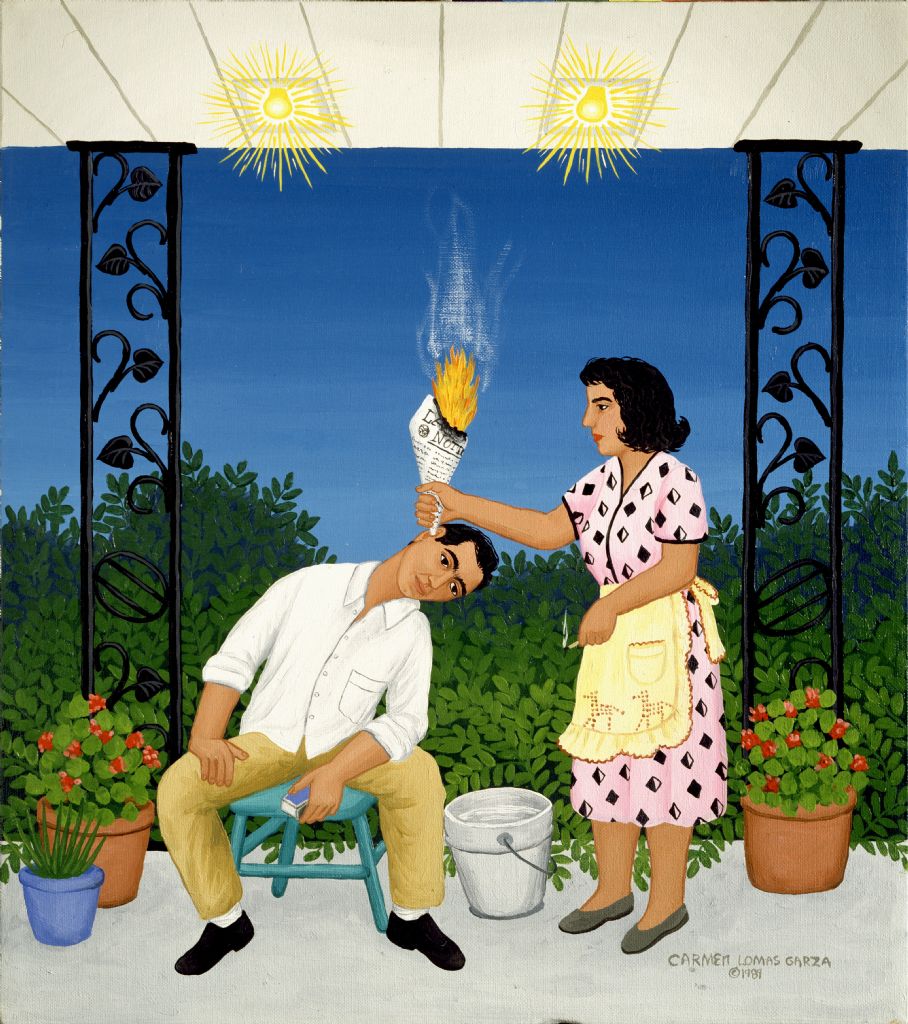Looking through Carmen Lomas Garza’s art, I genuinely felt the relatability of her images. As I flipped through the pages, I caught myself reflecting on my own memories and experiences growing up as a first-generation Chicana. Although I found myself in most of Garza’s pieces, Earache Treatment really stood out to me. My mom has suffered from earache pain her entire life and as such, this remedy has become a staple of our household. I remember my mom starting conversations with random people at the swapmeet and a couple days later being at their houses so they could do the ventosa treatment on her. She’s been in strangers’ living rooms and in porches that resemble that of Garza’s work. That is the nature of ventosas to me. They are a testament to the power of traditional remedies as well as the community of our culture. As Constance Cortez delineates in the book, las ventosas serve as a vessels of the “knowledge born of cultural practice” (54). Ventosas do not fall under the Western framework of treatment, but rather reside within traditional medicine. As such they are often discarded as myth or placebo practices rather than “real, scientific” remedies. Recently, I read through an article that mentioned the only thing ventosas were good for was creating an ash deposit in the ear. If that is true, then why is it that ventosas have been one of the only treatments that have saved my mother from the agony of earaches. I love how Garza makes the painting so poignant. As do her other paintings, the work is a casual tribute to the everyday lives of Chicanx communities. They are the experiences we often think not much of, but are unique and powerful in their connection to our lives. This Earache piece brought back such a deep memory of helping my mother and it makes me all the more connected to Garza’s art.
This is the blog for the UCLA Chicanx Latinx Art and Artists course offered by the Cesar E. Chavez Department of Chicanx Central American Studies (CCAS M175, also Art M184 and World Arts and Cultures M128). This course provides a historical and contemporary overview of Chicanx Latinx art production with an emphasis on painting, photography, prints, murals and activist art.
Monday, October 25, 2021
Jimenez-Briseño, Diana (Week 5)
Looking through Carmen Lomas Garza’s art, I genuinely felt the relatability of her images. As I flipped through the pages, I caught myself reflecting on my own memories and experiences growing up as a first-generation Chicana. Although I found myself in most of Garza’s pieces, Earache Treatment really stood out to me. My mom has suffered from earache pain her entire life and as such, this remedy has become a staple of our household. I remember my mom starting conversations with random people at the swapmeet and a couple days later being at their houses so they could do the ventosa treatment on her. She’s been in strangers’ living rooms and in porches that resemble that of Garza’s work. That is the nature of ventosas to me. They are a testament to the power of traditional remedies as well as the community of our culture. As Constance Cortez delineates in the book, las ventosas serve as a vessels of the “knowledge born of cultural practice” (54). Ventosas do not fall under the Western framework of treatment, but rather reside within traditional medicine. As such they are often discarded as myth or placebo practices rather than “real, scientific” remedies. Recently, I read through an article that mentioned the only thing ventosas were good for was creating an ash deposit in the ear. If that is true, then why is it that ventosas have been one of the only treatments that have saved my mother from the agony of earaches. I love how Garza makes the painting so poignant. As do her other paintings, the work is a casual tribute to the everyday lives of Chicanx communities. They are the experiences we often think not much of, but are unique and powerful in their connection to our lives. This Earache piece brought back such a deep memory of helping my mother and it makes me all the more connected to Garza’s art.
Subscribe to:
Post Comments (Atom)

No comments:
Post a Comment